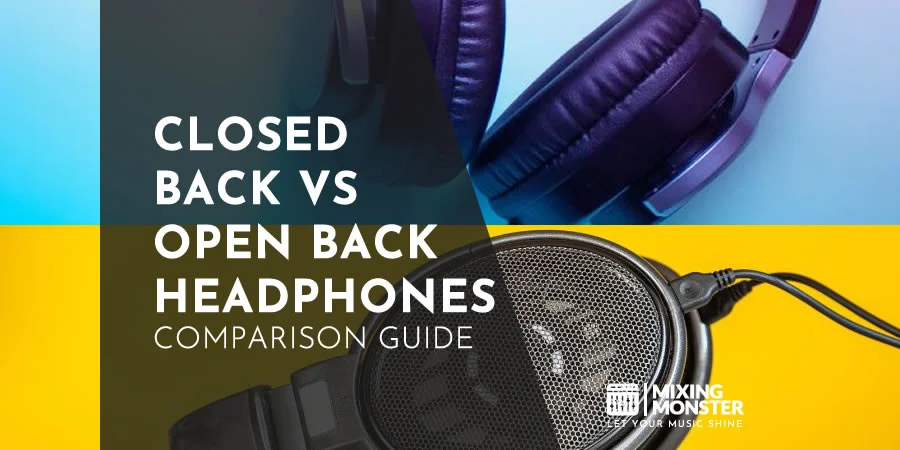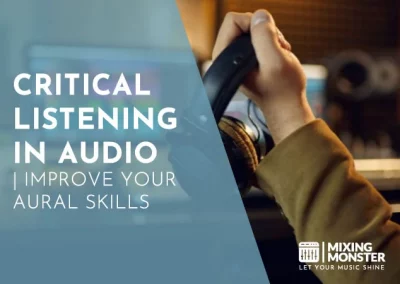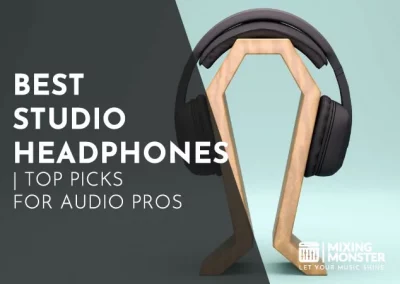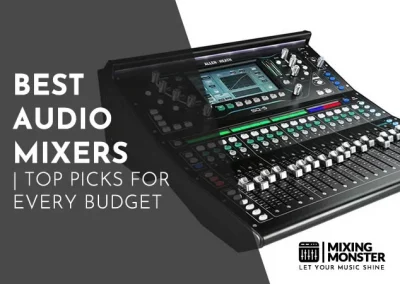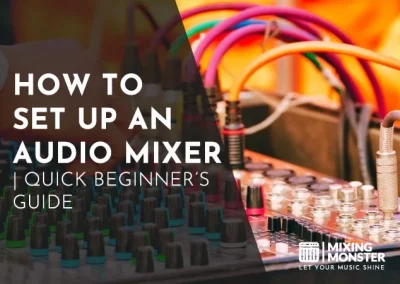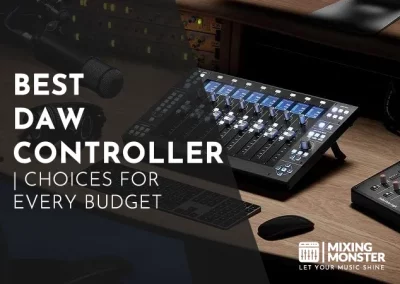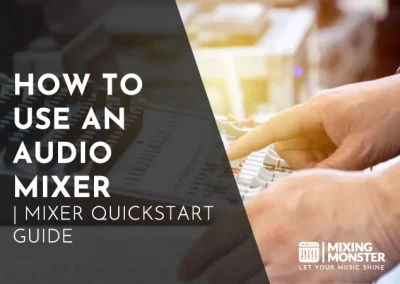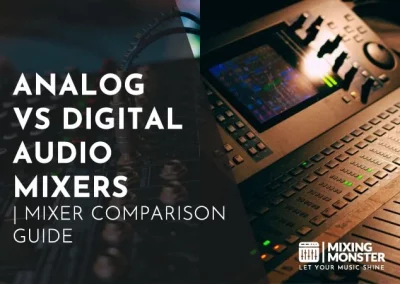Home > Blog > Studio Gear > Mixing Gear
Disclosure: Some of the links below are affiliate links, meaning that at no additional cost to you, we will receive a commission if you click through and make a purchase. Read our full affiliate disclosure here.
Audiophiles often face a critical decision when choosing the right headphones: closed-back vs. open-back headphones. Each type brings a unique auditory experience that can significantly affect how you listen to music or produce audio content.
Closed-back headphones feature a design where the outer part of the headphone cups has a solid enclosure, effectively isolating the listener from the environment. This design minimizes sound leakage, ensuring that the audio doesn’t emanate from the headphones, which can be particularly beneficial in noisy situations where external sound isolation is essential. Conversely, open-back headphones have a perforated or mesh-covered enclosure, allowing sound to escape and air to pass through the earcups, creating a more natural and expansive soundstage.
Understanding the nuances between these two headphone types becomes essential as you continue to explore the depths of audio fidelity. You’ll discover how the closed-back design might make a difference in your daily commute and why open-back headphones could be the gateway to a more authentic listening experience during quiet evenings. The knowledge gained here will guide you to identify the best headphones for your personal or professional audio endeavors.
KEY TAKEAWAYS:
- Choosing between closed-back and open-back headphones is pivotal for audio enthusiasts.
- Each headphone type offers distinct benefits for sound isolation and listening experience.
- Understanding the differences is key to selecting the right headphones for your needs.
Table Of Contents
1. What Are Closed Back Vs Open Back Headphones?
2. Understanding Closed-Back Headphones
3. Understanding Open-Back Headphones
4. Benefits Of Closed-Back Headphones In Music Production
5. Benefits Of Open-Back Headphones In Music Production
6. Disadvantages And Limitations Of Closed Back And Open Back Headphones
7. Use Cases In Recording, Mixing, And Mastering
8. How To Decide Between Closed-Back And Open-Back Headphones
9. Recap of Closed-Back Vs. Open-Back Headphones
10. FAQ

1. What Are Closed Back Vs Open Back Headphones?
When selecting headphones, understanding the differences between closed-back and open-back designs can significantly impact your listening experience, especially in music production.
Brief Overview Of Closed-Back Vs. Open-Back Headphones
Closed-back headphones are designed with a solid outer shell that prevents air and sound from passing through the ear cups. This design isolates you from external noise and contains the sound within the headphones. The result is a private listening experience where the audio is confined closely to your ears.
The ear cups are constructed with a perforated or mesh backing with open-back headphones, allowing air and sound to flow freely in and out. Despite potential sound leakage, this design offers a more natural and spacious sound field, resembling the acoustics of listening to live music.
Importance Of Choosing The Right Headphones For Music Production
Your choice of headphones is crucial for music production, as it affects how you perceive and edit sound. Closed-back headphones offer the advantage of sound isolation, essential when recording vocals or instruments to prevent the backing track from bleeding into the microphone.
In contrast, the design of open-back headphones provides you with a broader soundstage and improved fidelity, which can be especially beneficial during the mixing and mastering stages, allowing for more critical listening and a more accurate representation of how the sound will be heard in the open environment.
2. Understanding Closed-Back Headphones
When exploring the world of headphones, you’ll find that closed-back models are popular for their ability to isolate sound and minimize leakage.
Definition And Basic Characteristics Of Closed-Back Headphones
Closed-back headphones are designed with earcups that have a solid outer shell, creating a sealed acoustic environment. This design traps sound within the earcups and largely prevents it from escaping.
It also helps block out environmental noise, enhancing your listening experience. When wearing closed-back headphones, noise isolation is typically higher than open-back designs, making them a preferred option in noisy environments.
How Closed-Back Headphones Affect Sound Isolation And Leakage
The sealed nature of closed-back headphones doesn’t just offer better noise isolation; it also impacts the sonic characteristics of your music. You’ll notice a pronounced bass response, as the closed design naturally emphasizes lower-frequency sounds. Additionally, these headphones prevent sound leakage, meaning others won’t easily hear what you’re listening to.
This is particularly beneficial if you’re in a quiet setting like a library or if you’re engaged in recording activities where microphone bleed could be an issue. However, it’s important to remember that not all closed-back models have active noise-canceling technology; this is a separate feature that can further reduce ambient sounds.
3. Understanding Open-Back Headphones
When considering open-back headphones, you’re exploring a design that embraces natural sound and spaciousness, offering an experience akin to listening to live music in a room.
Definition And Basic Characteristics Of Open-Back Headphones
Open-back headphones feature ear cups with vents or grills that allow air and sound to pass freely in and out. This design choice is intentional, differentiating them from closed-back headphones in several aspects, notably in how they handle ambient noise and the sensation of breathability for the listener.
With open-back headphones, you might find a greater sense of comfort during extended listening sessions due to their typically lighter clamping force and the airflow afforded by the open-ear cups.
How Open-Back Headphones Provide A Natural Soundstage
The hallmark of open-back headphones is their ability to deliver a natural soundstage. The perforated ear cups prevent pressure buildup, ensuring sounds are not confined. This often leads to a more accurate representation of how sound travels and interacts in an open environment.
This design promotes an open sound that can make you feel like the music is emanating from around you rather than being pushed directly into your ears. The spacious soundstage these headphones offer is especially appreciated by audiophiles and professionals who seek an authentic listening experience.
4. Benefits Of Closed-Back Headphones In Music Production
Closed-back headphones provide specific advantages in music production, particularly when achieving pristine audio capture and maintaining sound integrity in the studio.
Superior Isolation For Recording Vocals And Instruments
When you’re recording, sound isolation is crucial. Closed-back headphones excel by significantly reducing the external noise that reaches your ears. This noise-canceling effect ensures that what you monitor is a more accurate representation of the sound without ambient noise interference.
Studio headphones must provide a clean and isolated monitoring path for vocal sessions so the artist can focus on performance without distraction.
Minimizing Sound Leakage In Sensitive Audio Environments
A notable feature of closed-back headphones is their ability to minimize sound leakage. This is especially beneficial in sensitive recording environments where bleed-through from the headphone mix to live microphones can compromise the sound quality of the final track.
In addition to offering clearer audio for recording, this characteristic ensures that microphones only capture the sounds you intend them to, without the risk of picking up what you’re monitoring.

5. Benefits Of Open-Back Headphones In Music Production
Open-back headphones are highly prized in music production for their superior sound quality and immersive listening experience, especially during critical phases like mixing and mastering.
Enhanced Audio Quality For Critical Listening
When you’re performing critical listening, the accuracy of audio reproduction is paramount. Open-back headphones enable a natural flow of sound into your ears, creating a wide and expansive soundstage. This typically translates into a more accurate placement of instruments within a stereo mix, making them an invaluable tool for discerning audiophiles and sound engineers.
The open design also helps reduce the pressure and reflective sound buildup you might experience with closed-back models, resulting in a clearer and less colored sound. This quality is especially crucial when you want to listen to the nuances of a track and make precise adjustments during mastering.
The Role Of Open-Back Headphones In Mixing And Mastering
During mixing and mastering, your ability to hear the truth of the sound without the influence of external noise is crucial. Open-back headphones are designed to offer transparent sound reproduction, which ensures that you hear the mix as it is, without the added bass or treble that some headphones might introduce. This level of detail can help you make more informed decisions about balance, panning, EQ, and dynamic processing.
Furthermore, since open-back headphones can provide a natural and open listening experience, they create an environment similar to listening through studio monitors. This aspect is particularly beneficial if you’re mixing in a room that’s not acoustically treated, as it allows you to approximate how your mix would sound in an ideal listening environment.
6. Disadvantages And Limitations Of Closed Back And Open Back Headphones
While closed-back and open-back headphones have unique benefits, they also have specific disadvantages that can affect your listening experience depending on your environment and needs.
Drawbacks Of Closed-Back Headphones In Detail
- Isolation Vs. Pressure:
You’ll find that closed-back headphones offer excellent isolation from outside noise, which allows for private listening. However, this isolation can also lead to a low-frequency buildup, potentially muddying your sound. - Comfort Concerns:
The design that blocks external sound can also result in heat and discomfort over extended periods of wearing. - Sound Quality:
Although closed-back headphones provide privacy, their closed nature can sometimes result in a less natural or narrow soundstage when compared to open-back headphones.
Drawbacks Of Open-Back Headphones In Detail
- Natural Sound Vs. Privacy:
Open-back headphones typically deliver a more realistic and natural sound by allowing air and sound to pass freely through the earcups. However, this openness means your music leaks out, reducing your privacy and potentially disturbing others. - No Outside Noise Isolation:
If you’re in a noisy environment, open-back headphones won’t block out outside noise, which can be intrusive and diminish your listening experience. - Fragility:
Due to their construction to allow airflow, open-back headphones can be more fragile and susceptible to damage from the elements, like dust and moisture, compared to their closed counterparts.
7. Use Cases In Recording, Mixing, And Mastering
Choosing the correct type of studio headphones is crucial for your workflow and the quality of your recording, mixing, and mastering processes.
When To Choose Closed-Back Headphones
In recording, especially when tracking vocals or acoustic instruments, closed-back headphones are essential to prevent sound from leaking into the microphone and causing feedback or recording bleed.
Isolation is vital; these headphones block external noise and keep the monitor mixed in your ears only. Closed-back headphones are a clear choice for detailed work where you must concentrate on individual elements without outside noise interference.
When To Choose Open-Back Headphones
Open-back headphones are often preferred during mixing and mastering because they provide a more natural and open soundstage. This is because they allow some air to pass through their earcups, which can lead to a more accurate representation of how sound will travel in a room.
Open-back headphones like those found in many professional studios can be advantageous when you’re critically listening and want a sense of how the mix will sound in a real-world environment.
Examples In Music Production Settings
- Recording:
You’re laying down a vocal track and must ensure a clear sound without bleeding. Closed-back headphones, like those noted for their sealing ear cups, can optimize your recording environment. - Mixing:
A pair of open-back headphones can offer perforated housing to achieve a well-balanced mix, which might translate to less ear fatigue and a clearer sense of space and depth in your tracks. - Mastering:
The mastering process calls for highly detailed sound analysis. Open-back headphones with a wide frequency response found on platforms like Waves Audio may allow you to evaluate subtleties in your master with precision critically.
By selecting the appropriate type of studio headphones for recording, mixing, or mastering, you can maximize your experience’s quality and output.
8. How To Decide Between Closed-Back And Open-Back Headphones
When choosing between closed-back and open-back headphones, focus on specific use cases and personal tastes. The following subsections will guide you through the essential considerations.
Factors To Consider Based On Your Production Needs
- Studio Use:
Closed-back headphones are typically advisable for recording in a studio due to their sound isolation capabilities. This design minimizes sound leakage, ensuring that microphones don’t pick up the headphone output. On the other hand, open-back headphones may be preferred for mixing and mastering because they provide a natural and wide soundstage, which helps make detailed adjustments to the mix. - Live Monitoring:
In live environments where isolation is vital to hear your mix clearly, closed-back headphones are almost universally the choice. - Isolation:
Consider closed back if you need to prevent audio leakage. - Soundstage:
Opt for an open back if a natural and broad listening experience aids your production workflow.
Personal Preference And Comfort
- Listening Duration:
For extended periods of use, comfort is paramount. Open-back headphones are lighter and allow more air circulation, often reducing ear fatigue. - Sound Quality and Experience:
Open-back headphones generally offer a more expansive soundstage, giving the feeling of listening to music in a room rather than inside your head. If you’re seeking immersive listening, this might align with your preference. - Comfort:
Assess the weight and fit for long-term comfort. - Personal Taste In Sound:
Consider prioritizing an intimate sound (closed back) or a spacious acoustic experience (open back).
Remember, the best headphones for you combine optimal sound quality with comfort that suits your preference and aligns with your production needs.
9. Recap Of Closed-Back Vs. Open-Back Headphones
In assessing the merits between closed-back and open-back headphones, you must consider your precise needs as a listener or music producer. The choice can significantly affect your audio experience.
Final Recommendations For Music Producers
As a music producer, your choice between open-back and closed-back headphones will hinge on the specific demands of your working environment and sound fidelity needs.
Open-back headphones typically offer a superior soundstage, allowing for a natural spread of audio that mimics speakers. However, they tend to leak sound and lack isolation, which can be problematic in studio settings where microphones could pick up bleed.
Conversely, closed-back headphones provide excellent sound isolation, essential when recording vocals or acoustic instruments, as they prevent the headphone monitor mix from leaking into the live microphones. They might deliver a different width in soundstage than open-back designs but offer a more intimate listening experience, which may be beneficial during meticulous editing and mixing sessions.
Here’s a brief comparison to help you align your headphone choice with your production requirements:
| Feature | Closed-Back Headphones | Open-Back Headphones |
|---|---|---|
| Sound Isolation | Excellent – Prevent sound leakage, good for recording in the same room | Low – Sound leaks, not ideal for recording scenarios |
| Soundstage | More confined – Offers a direct and isolated sound | Wide and natural – Simulates a room-like experience |
| Use Case | Ideal for recording sessions, noisy environments, and focused listening | Suited for mixing and mastering in quiet, controlled environments |
| Portability | Better suited – for use in various locations due to sound isolation capabilities | Less portable – sound leakage can disturb others, better for a dedicated space |
Remember, both types have their place in music production, and your decision should reflect where you place the most value—isolation for recording or natural sound for mixing and mastering.
Choose the style that best fits your work and listening preferences!
10. FAQ
1) What are the advantages of using closed-back headphones for studio recording?
Closed-back headphones are favored in studio settings primarily because they provide excellent sound isolation, keeping the track playing in your headphones from leaking into the recording microphone. They create an intimate soundstage, making them suitable for monitoring during recording sessions.
2) How do open-back headphones enhance the experience of listening to music?
Open-back headphones offer a natural and spacious soundstage, making listening to music feel like you’re at a live performance. The design allows for a more airy and transparent sound, providing a more immersive listening experience.
3) What are the primary differences in sound quality between closed-back and open-back headphones?
The sound quality of closed-back headphones generally offers a more direct and isolated listening experience, enhancing bass frequencies and delivering a punchier sound. In contrast, open-back headphones provide a wider soundstage and more natural sound, emphasizing clarity and detail across frequencies.
4) Can open-back headphones be a good choice for gaming, and if so, why?
Open-back headphones can be excellent for gaming because they offer a more expansive and realistic soundstage, which helps accurately pinpoint in-game directional cues. This quality can enhance your situational awareness and immersion in the game environment.
5) What are the potential drawbacks of using open-back headphones in public or office environments?
The main drawback of using open-back headphones in public spaces is that they allow sound leakage, which means those around you can hear your music. Similarly, they don’t block ambient noise, which can distract you and others in quiet settings like offices.
6) In terms of sound isolation and leakage, how do closed-back headphones compare to open-back models?
Closed-back headphones excel at sound isolation, preventing external noise from entering and keeping the audio within the ear cups. This makes them ideal for noisy environments. On the other hand, open-back headphones have little to no sound isolation, which will leak sound and allow ambient noise to mix with your audio.

